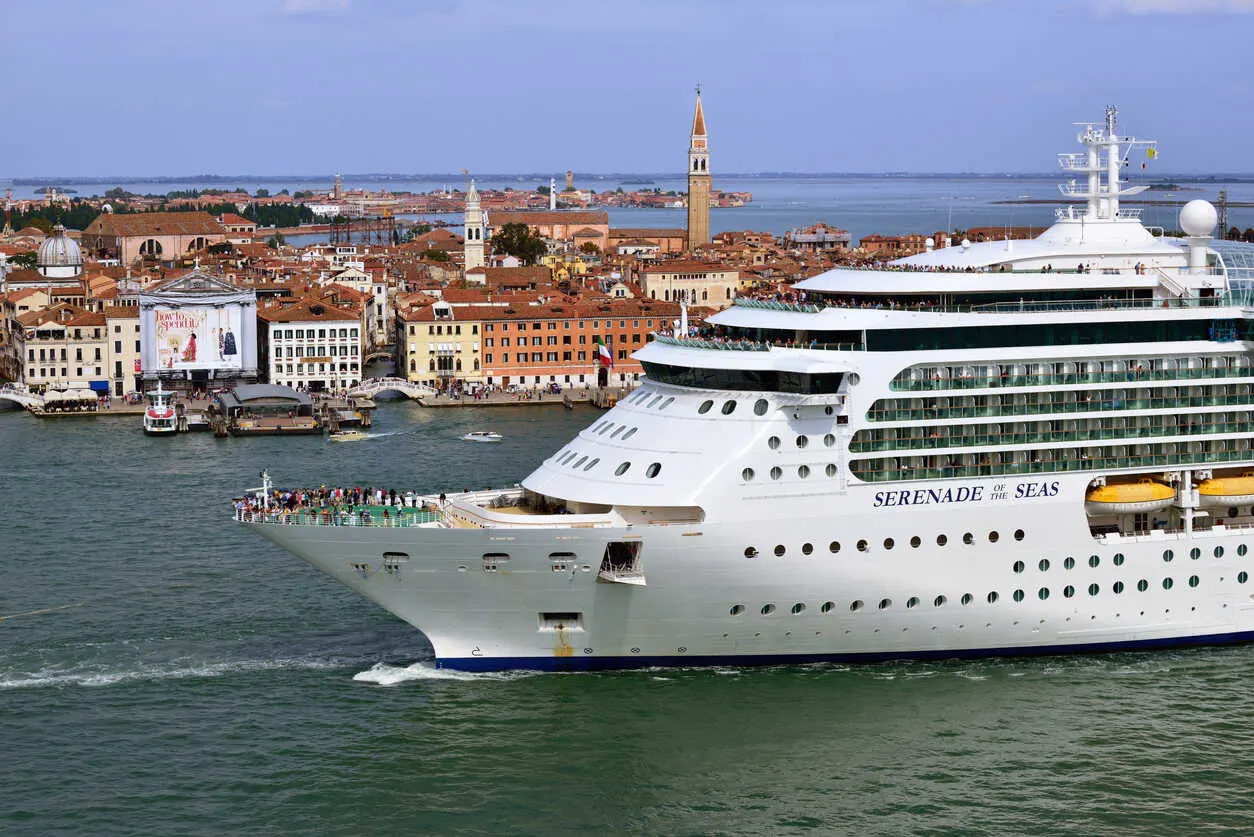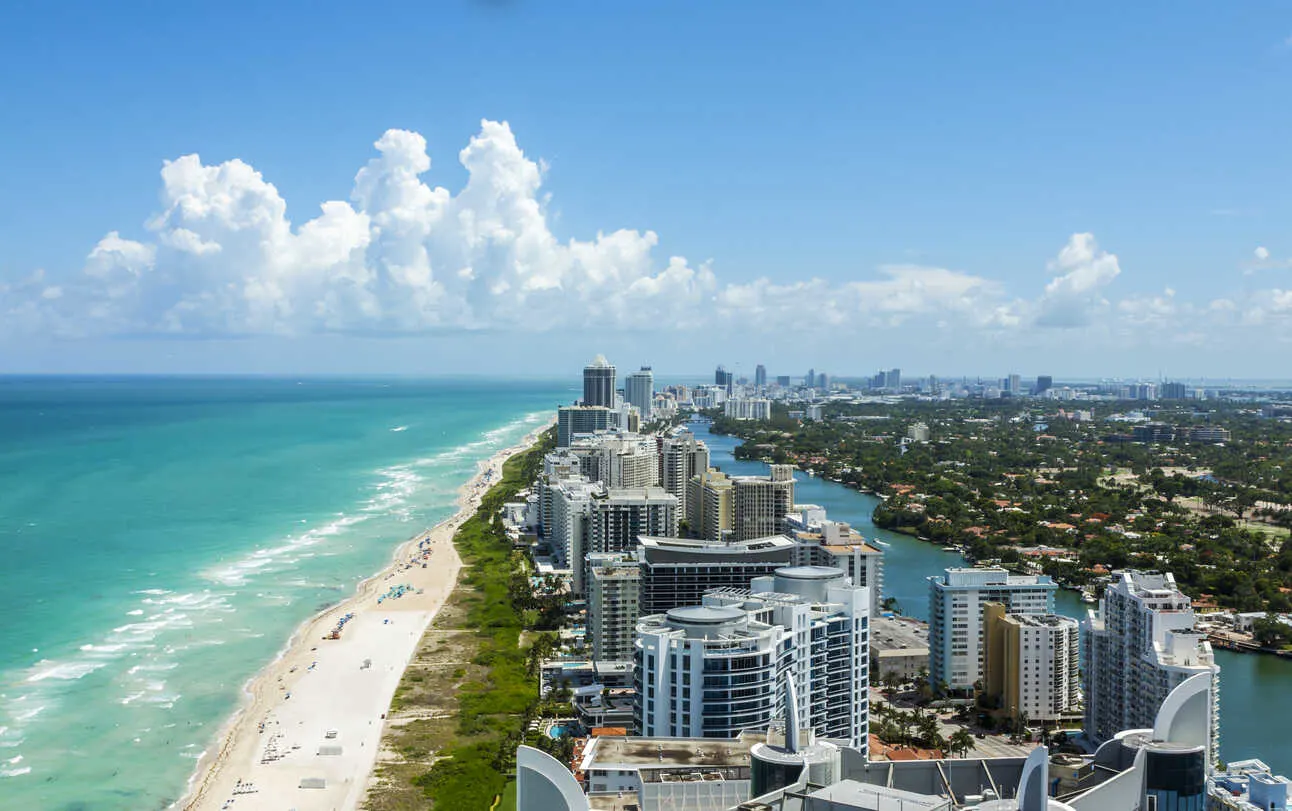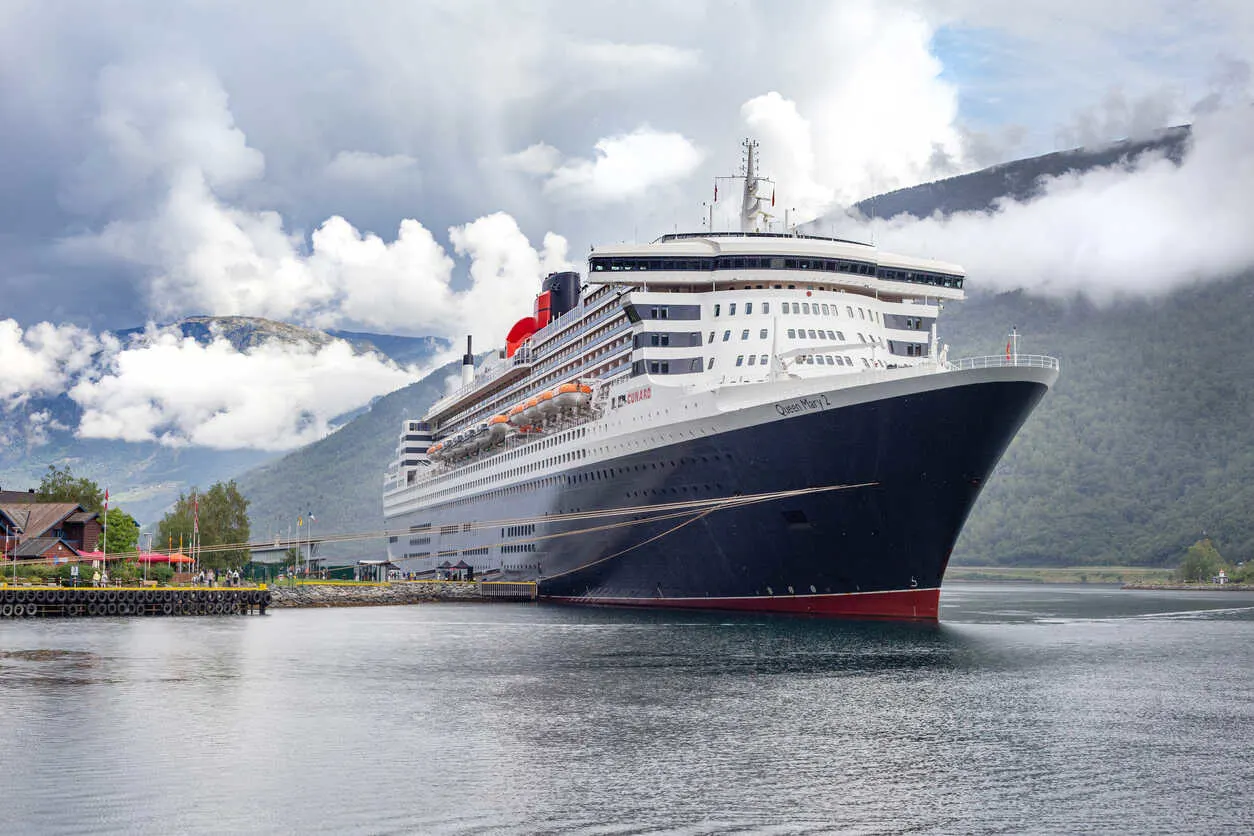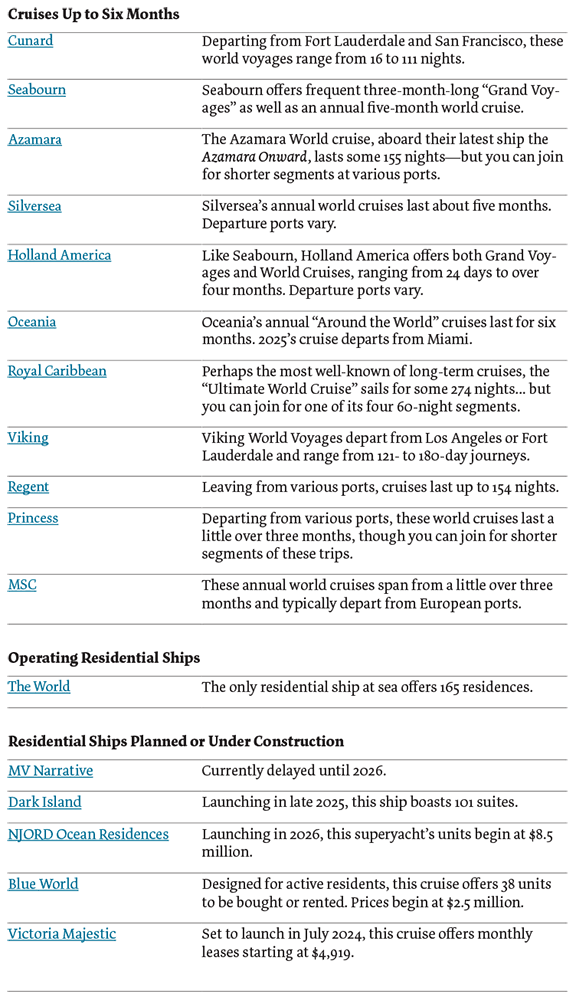Well before The Love Boat dominated late ‘70s television, my family took a Caribbean cruise aboard a lesser-known passenger ship.
It was rudimentary compared to today’s offerings: no balconies (okay, maybe there were a few balconies, but my parents were too cheap for that), no rock climbing walls, no waterparks, no grand boulevard malls or sprawling gyms and spas. This ship was about the experience of the sea… melting into a deck lounger with a book, or simply gazing at the horizon, where cobalt sea meets powderblue sky.
It was nothing short of magical.ft
Since then, I’ve sailed on 40+ ship experiences (to be honest, I’ve lost count). The journeys have varied, from navigating Patagonian glaciers to river cruises on the Amazon. And I’ve upgraded from that rudimentary ship of yesteryear, traveling on massive Caribbean cruise ships and elegant ocean liners alike.
Yet all these cruises share one similarity: On the day of disembarkation, I am nowhere near ready to leave behind my life aboard. Before docking, I dream about world cruises… or even living on a residential ship.
And these are no pipe dreams.
How to Move Out of the U.S.
How to Move Out of the U.S.
In all sorts of beautiful, welcoming, culturally rich, saner places around the world, you can live well from $2,000 a month (all in, housing included). Sign up for our free daily IL Postcards e-letter and we’ll immediately send you a free report on the WORLD’S # 1 RETIREMENT HAVEN— plus 9 more spots you should have on your radar. Each day, you’ll earn about the best places to move to, retire, travel, buy real estate, and enjoy a good life for less, overseas.

By submitting your email address, you will receive a free subscription to IL Postcards, The Untourist Daily and special offers from International Living and our affiliates. You can unsubscribe at any time, and we encourage you to read more about our Privacy Policy.
Cruising Full-Time
The ultimate example is 74-year-old Mario Salcedo, or "Super Mario" as he’s called by his fans.
Since 1997, Mario has cruised with every major cruise line—but since 2000 (apart from a hiatus during the COVID-19 shutdown), he’s been living on a Royal Caribbean liner for an (almost) nonstop tour around the world.
He spends 15 days on land annually for medical checkups and the like. He’s recently reached the 10,000-point mark with Crown and Anchor Society—the RCL loyalty program. That’s one point per night on board.
Mario worked for a multinational corporation as an international finance director. He estimates that he traveled to 90% of Latin America during his time in the corporate grind, accruing millions of miles on airline loyalty programs. When he experienced corporate burnout, he founded a small business where he could work from anywhere and take advantage of his miles.
But he quickly became dismayed by air travel, decided to take his first cruise in 1997, and never looked back.
Cruising used to cost him between $60,000 and $70,000 every year, but with year-to-year inflation, that’s up to $82,000. For comparison, the average assisted living retirement communities can cost an estimated $54,000 per year – and that certainly doesn’t involve travel to exotic ports of call.
Mario developed a credit card point strategy for upgrades. To finance flights to cruise ports, he uses the points he accrues by booking cruises with credit cards. And, with his top-tier loyalty status, he has free Wi-Fi, which he uses to work as an investment manager.
It’s possible to live on a commercial cruise ship like Mario. But it can be tricky. You can book back-to-back cruises on the same commercial cruise ship, but if you want the same cabin throughout your journey, you’ll need to purchase it as soon as the bookings open 18–24 months in advance. Two years ahead of departure, Mario books less-desirable inside cabins to maximize the chances of remaining in the same room.
With this plan, you’ll have to commit to one cruise line.
Another option is "skip hopping." With this method, you book your next cruise(s) while on your current one, looking for deals out of a port you can easily fly or drive to. Many cruises offer cheap last-minute rates and inexpensive repositioning cruises.
But this method can be stressful, requiring you to constantly research your next cruise, and can leave you out in the cold if cabins are unavailable at your next disembarkation port.
The alternative: a long-term cruise.
Long-term cruising is becoming popular for retirees and digital nomads, with many cruise lines now offering partial (three-month) or complete (six-plus months) world cruises. In fact, the launch of Royal Caribbean’s latest nine-month cruise recently went viral on social media, thanks to a marketing strategy designed to attract digital nomads.
World cruises tend to be more expensive; just ask 76-year-old solo traveler Andrea Dalessandro, who planned to board an around-the-world three-yearlong cruise last November.
The all-inclusive, 1,001-day world cruise advertised a round-trip itinerary beginning in Istanbul and covering some 130,000 miles across 140 countries and all seven continents—stopping at a whopping 382 ports. Stops included most of the world’s bucket list destinations, down to the seven wonders of the world. I researched the itinerary with envy.
Funding such an extended trip, which rings in at $170,000 for an inside cabin with Andrea’s 12% early-bird discount, is no drop in the bucket. I did the math; that’s nearly $170 per day.
However, some dreams are just pipe dreams. More on Andrea later.

The World’s Only Residential Ship
The World is a 165-condo luxury residential ship launched in 2002 with an average occupancy of 150–200 guests. It’s privately owned by the residents, not unlike a condo association, and the only one of its kind—for now.
The ownership community consists of approximately 150 families who hail from some 20 countries throughout North America, Europe, Asia, Australia, South America, and Africa. With rumored neighbors like Arnold Schwarzenegger and Madonna, and a $10 million asset requirement to qualify for ownership, the price tag for this kind of floating apartment is out of reach for most retirees.
Aussies Tony and Sue De Leede, now in their early 70s, owned a 1,100-square-foot two-bedroom plus studio/den apartment on The World for eight years.
"I’ve missed it a lot," Tony confides. "We enjoyed the people on The World. It was perfect for us."
They also loved the luxury afforded by a well-appointed ship and a high-profile clientele. The De Leedes are discerning foodies and were impressed with the chef’s capabilities and extensive wine list at sea. In fact, they enjoyed dining out so much, they rarely used their kitchen.
The couple owns several health and wellness retreats in Australia and Bali. "When we bought [our apartment on The World] in 2005, technology was not what it is today. It was fairly challenging for work," says Tony. He and Sue needed to be hands-on with the businesses, leaving them only four months out of the year to live on The World.
"I could have quite easily spent more time aboard, like six to eight months," says Tony. "I am ready to slow down now. But at that time, I couldn’t."
According to Tony, only about 10 to 15 people live permanently on The World. The company also has a Guest Stay Program for renting.
"We rented our apartment direct to business associates or as trade out with my lawyer and accountant," Tony shares.
You’re not going to find an apartment on The World on Airbnb, however. Prices run between $2,300 per night for a studio (with a minimum five-night stay) up to $20,000 a night for a suite.
"We loved it," says Tony. "I was sad when I got off the ship for the last time."
Since then, the De Leedes have purchased a condo on a new conceptual residential ship, Storylines’ MV Narrative. Although not fully retired, Tony has eased off his company responsibilities and will be able to enjoy the luxury of time off the grid.
"I’m excited this time," says Tony, "because I can bring my dog."
Test the Waters by Renting at Sea

The De Leedes aren’t alone in their love of seafaring. John (76) and Melody (63) Hennessee are lifelong boaters from Port Salerno, Florida.
They lived and worked on the waterfront as owners of the Fish House Art Center and Marina—housing several shops and a full-service marina. In 2021, they began preparing for retirement and started the process of selling and donating all their "stuff," ultimately selling their waterfront business and primary residence. (Read how to prepare your belongings for an international move here.)
In January 2022, the couple signed up for the nine-month Ultimate World Cruise aboard Royal Caribbean’s Serenade.
"Then, within a week of signing up, we saw a Facebook post about Storylines," says Melody. They took their nine-month cruise and are now taking back-to-back cruises while they wait for their next grand adventure… aboard Storylines’ MV Narrative.
MV Narrative is an eco-friendly ship designed as a "floating neighborhood" for some 1,000 full-time residents, and promises to circumnavigate the globe every 1000 days, staying at ports voted on by the owners. It boasts 18 decks, 20 restaurants and bars, three pools, an organic garden, state-of-the-art tech for digital nomads, a full gym and spa, and even a "school" for the children on board. Fully-furnished units range from one to four bedrooms, most with balconies, and go for $875,000 to $7,600,000.
It’s a pretty sweet deal. The catch: MV Narrative doesn’t exist yet.
The MV Narrative was first announced in 2019 with a delivery date of 2023. It is a little confusing but the ship that was supposed to set sail in 2019 was an older refurbished vessel as part of a previous business model, not MV Narrative. According to Storylines’ most recent press release, the ship is currently under construction in Croatia, and its launch date has been pushed back to December 2026… making some wonder if MV Narrative will ever come to fruition.
Yet over half of the apartments are sold, and these potential residents—John and Melody among them—are hard-core believers.
Residents will never have to cook or clean again.
"We researched it and said, ‘This is perfect for us!’" says John "We sent in our deposit for a RU-3 residence in January 2023." This 538-square-foot layout features an enclosed glass bedroom (with privacy curtains), a walk-in wardrobe, a bathroom with a shower/tub, a living room and workspace, a wet bar, and a balcony.
Although the Hennessees didn’t reveal what they paid for their condo aboard Storylines (they got in on the ground floor), an RU-3 today is listed at $2.7 million for full purchase.
There are also monthly fees for this all-inclusive lifestyle, which will run between $4,770 and $9,600 per person based on the square footage of each unit.
Storylines has added limited shared purchase (multi-person) ownership options to their offerings, too. It’s not a lease, so you can sell your share at any time. You can own a 25% share of a condo and stay for a three-month stint during each year. Twenty-five percent shares are available for two residence types; the RU-2 Explore and the RU-4 Dream. Fifty percent co-ownership shares are currently available for all residence types and range from $550,000 to $4.4 million.
That said, this is a less expensive choice for those testing the waters. According to John and Melody, that was not an option for them.
"We plan on being full-time residents till death do us part," they laugh.
At time of publishing, they’ll be in Asia boarding the next leg of an NCL cruise—after spending the holidays in the US visiting family.
"We have our cruises booked through the end of 2024 already," shares Melody.
The pair feels that the up-front cost of back-to-back cruising is well worth the lifestyle.
"We haven’t done a detailed analysis, but we’re certain that our living expenses today are less than when we lived on land," says John. "Our only bills today are for our cruise ship bill, our cell phone, and eating and drinking when on shore. No more insurance for our home, business, cars, no utilities, no grocery and bar tabs, no rent, mortgage, or property taxes, no vehicle and fuel expenses."
But there are some unusual challenges that come with living at sea…
The Drawbacks of Living on a Ship
It’s nearly impossible to receive any mail or shipments while on cruise ships (though that won’t be an issue on MV Narrative, which will have its own post office). Meanwhile, the Hennessees have converted all their accounts to paperless and conduct their bookkeeping online.
MV Narrative is designed to feel like a floating community, where you can pop over to the pub, enjoy a show with your neighbors, or hang out in the library reading a new novel. But some say that being on the sea leaves you feeling "trapped." During an ocean crossing, you can’t just get in your car and go somewhere when you feel like it (in fact, you won’t even have a car).
Storage becomes an issue, too. Our lifestyles and homes are designed for collecting "stuff" we think we need. The downsizing challenge is real.
So think carefully if you can fit your life into a few suitcases or if you will need storage with a family member or a facility on land. The Hennessees are downsizing masters, but I could never fit all those sentimental items and art into just a 538-square-foot home.
Living full-time on an all-inclusive ship outweighs those inconveniences. The Hennessees will never have to cook, clean, do laundry, or grocery shop again.
"We won’t miss any of that," Melody says.
MV Narrative residents have the option to dine at one of the 20 restaurants on board, or order from 24-hour room service. Kitchenette amenities depend on the residential unit size, type and upgrades chosen. The smaller units do not have a kitchen sink, but they do have a refrigerator, toaster oven, microwave and coffee maker. The larger residences have kitchenettes with cooking amenities.
And it’ll be hard to be bored aboard the MV Narrative. The ship is slated to offer rotating live entertainment, with different acts embarking at different ports. The deck plans also boast a 10,000-book library, a micro-brewery, a movie theater, a golf simulator, classes (such as cooking and wine pairings, painting, health and fitness), and board/card games and tournaments.
But there’s one thing I’ve found expats do miss: Family.
That’s not a concern for John and Melody, though. "Our children and grandchildren love cruising with us," Melody says.
And because they own their home on MV Narrative, they can have guests join for segments of the trip.
How to Move Out of the U.S.
How to Move Out of the U.S.
In all sorts of beautiful, welcoming, culturally rich, saner places around the world, you can live well from $2,000 a month (all in, housing included). Sign up for our free daily IL Postcards e-letter and we’ll immediately send you a free report on the WORLD’S # 1 RETIREMENT HAVEN— plus 9 more spots you should have on your radar. Each day, you’ll earn about the best places to move to, retire, travel, buy real estate, and enjoy a good life for less, overseas.

By submitting your email address, you will receive a free subscription to IL Postcards, The Untourist Daily and special offers from International Living and our affiliates. You can unsubscribe at any time, and we encourage you to read more about our Privacy Policy.
A Floating Hospital

The medical center aboard Storylines’ MV Narrative is anticipated to include a full-time general practitioner with ER training, a preventative medicine physician; a nutritionist, an acupuncturist; an aesthetician; a physical therapist, a dental hygienist, and two to four physician’s assistants and nurses.
The facilities will be like most small, acute care clinics on land, and will include intensive care units, treatment and exam rooms, and even a dedicated isolation and infection control area.
Equipment will include wheelchairs, a stretcher, lab capabilities for standard blood and urine tests, oxygen tanks, an EKG, plus defibrillators and cardiac monitors. That’s not to mention a dialysis machine, CPAP machines, electronic infusion devices, mechanical ventilators, and a helicopter landing pad for medical evacuations… and a compounding pharmacy.
With all this, John and Melody aren’t too worried—especially given that they’re active and healthy. John’s a retired emergency physician, and thanks to the top-notch medical facility, he’s confident that the ship will be able to handle most medical issues.
Several years ago, the couple signed up for SkyMed: a medical evacuation program that pays for the expenses of getting you, your family, and pets transported to the medical facility of your choice worldwide. It cost $2,500 for a five-year plan for the couple.
John also has Medicare, while Melody has a medical savings plan. But Medicare will only cover Americans while they’re in the US.
"We’re basically depending on our good health and our program of healthy living to keep us on track," says John.
The Logistics of Living Far From Home
Even on a residential ship, space is limited. Many folks aboard plan to keep a second home or some sort of storage on land.
But the Hennessees have decluttered their lives to the envy of anyone who follows the "less is more" lifestyle.
"We’ve continued to get rid of all our stuff. We currently cruise with three regular suitcases, and three carry-on-size bags, plus my briefcase and Melody’s largest purse—she has narrowed it down to six. Packing has become my expertise," John laughs.
Even in the era of global connectivity, every cruise I’ve taken has had dubious Wi-Fi connection. It’s been spotty at best, with too many users on the same bandwidth, or obscenely expensive. This can be especially frustrating for digital nomads or those who need to keep in touch with people on land.
Take heed, fellow cruisers: Seek cruise lines equipped with Starlink if you’re in need of a stable internet connection. John notes that with Storylines’ top-of-the-line technology and Wi-Fi costs included with the HOA fee, these issues should mostly be alleviated.
And while the globetrotting Hennessees wait for their own home to set sail, they’ll continue to travel on back-to-back cruises.
Reader, Do Your Due Diligence
Remember Andrea and her three-year retirement cruise? The cruise company’s purchase of the ship set to circumnavigate the world fell through at the last minute—leaving Andrea and 100+ other passengers stranded in Istanbul after three delays and a final cancellation.
Instead, she and many others were put on a cruise to Rome and then onward to Florida. All passengers are supposed to see refunds.
"Perhaps it was just a Camelot dream," says Andrea. "Luckily, I have a home and a car to return to. Many didn’t."
An important lesson from her experience: For cruises of any length, it’s essential to book through reputable cruise lines and check that the ship already exists—and is in possession of the cruise line advertising it.
If a ship is in the process of being built… unless you can risk large sums of money, best to wait until after it sails out of the shipyard.
As for the De Leedes and the Hennessees, they feel secure that their investment is safe (buyers are told deposits are held in a trust account.) and they’re understanding about the delays holding back Storylines’ MV Narrative (including COVID-19, steel shortages, shipyard contracts, etc.). There is a $10,000 refundable deposit to reserve a specific residence aboard the ship. The "milestone" payments after that are:
20% upon signing the sales agreement
20% prior to steel cutting
20% prior to keel laying
40% prior to ship delivery
The milestone payments are nonrefundable. Therefore, one must carefully weigh the risk when purchasing prior to delivery.
Can You Make the Move?
There are several additional residential yachts in various stages of planning, with expected maiden voyages from 2024 through 2026 (see sidebar). Since this undertaking has only been successful with The World, further delays won’t be a surprise. Also note that these ships tend to cater to high-end, luxury homeowners—leaving most retirees without options to own.
One more affordable stand-out is the adults-only Victoria Majestic from Victoria Cruise Lines, set to sail in July 2024. (But they too have seen multiple delays, even though the cruise line continues to solicit $10,000 deposits asking guests to wire the money to a bank account in Budapest, Hungary—red flag?). The 27-year-old previous Holland America ship is allegedly being renovated for long-term onboard residents.
On this ship, you can’t purchase your cabin; they’re only available for rent, with a minimum six-month lease. The longer the lease, the bigger the discount.
For a standard internal cabin, the monthly charge ranges from $4,919–$8,199 for two people and is said to include the all-inclusive buffet and main restaurant with unlimited non-alcoholic drinks, beer, wine, use of self-service laundry facilities, change of bed linen once a week, change of towels three times a week, daily cleaning, free internet use, an onboard swimming pool, solarium, gym, animation programs, theater, themed shows, dances, and port charges.
Could you sell your home and live aboard a ship like this? Let’s do some simple math. Say you sell your home for $600,000. If you have a $5,000 per month cabin lease for two people, you could theoretically live on the Victoria Majestic for up to 10 years…
Compare that to the average retirement or assisted-living home in the US, which can cost $5,000+ a month (and many places you must buy your apartment first).
Would it make sense to live on a ship? This has my wheels turning.
I could keep my Costa Rican beach home on land and rent it on Airbnb to cover these monthly fees and supplement any low season months with other investment payoffs.
I could do it… if I could just find the perfect residential ship.
Cruising on the World’s Last Ocean Liner

When my husband and I researched our travel options from our home base in Malta to our other home base in Costa Rica last summer, we were astounded at how significantly the prices of business class flights had increased in a year. Between this and my recent abdominal surgery, which would make sitting upright in coach class for 10 hours difficult, we decided we needed to find a cruise
Although there are several transatlantic cruises during shoulder season, when ships are repositioning, we found none in mid-summer… except the Queen Mary 2, Cunard Line’s marquee ship. It promised seven nights of luxury, entertainment, and cuisine for less than a business class ticket across the pond! For a balcony cabin, we each paid just under $2500.
The Queen Mary 2 isn’t just any old cruise ship; this is the only ocean liner in the world still sailing. Ocean liners are built with thicker steel and deeper hulls (Remember the Titanic’s deadly encounter with an iceberg?) than your typical cruise ship. The QM2’s purpose is to take passengers from point A (Southampton, UK) to point B (Brooklyn, NY) or vice versa as quickly as possible. There are no ports-of-call on this route.
This grand dame still holds her own in the luxury department, ever since her maiden voyage in 2004 (the vessel was renovated in 2016). She’s also the only cruise or residential ship with a kennel, so passengers can take their pets home or on vacation. She also boasts the largest library at sea—with over 10,000 titles and plenty of quiet reading nooks. The planetarium offers a rotating schedule of shows. And there are renowned lecturers onboard with presentations from history to world events to arts and wine.
The atmosphere allows you to step back into a time before cruising became casual. You will not find Flow Rider surf simulators and water slides here, nor will the cruise director encourage drinking games and hairy chest competitions at the pool. Dress is causal smart by day and formal (sport coats, suits, tuxes, and dresses or gowns) by night. Ballroom dancers take to the floor nightly, card and board games occur throughout the day, and high tea is served by white gloved gentlemen every day at 3 p.m. in the Queen’s Room. You won’t experience jet lag traveling across so many time zones, either. Just one per night rather than all in a few hours. I recognize this sort of elegant cruising is not for everyone. In fact, my typically T-shirt-wearing husband grumbled when dressing in his tux on our second formal night.
But for me, taking my 40th-plus cruise, this transatlantic crossing was an unforgettable experience. In fact, it may become my preferred mode of transportation to Europe in our future.
Your Long-Term Cruise Options

How to Move Out of the U.S.
How to Move Out of the U.S.
In all sorts of beautiful, welcoming, culturally rich, saner places around the world, you can live well from $2,000 a month (all in, housing included). Sign up for our free daily IL Postcards e-letter and we’ll immediately send you a free report on the WORLD’S # 1 RETIREMENT HAVEN— plus 9 more spots you should have on your radar. Each day, you’ll earn about the best places to move to, retire, travel, buy real estate, and enjoy a good life for less, overseas.

By submitting your email address, you will receive a free subscription to IL Postcards, The Untourist Daily and special offers from International Living and our affiliates. You can unsubscribe at any time, and we encourage you to read more about our Privacy Policy.
